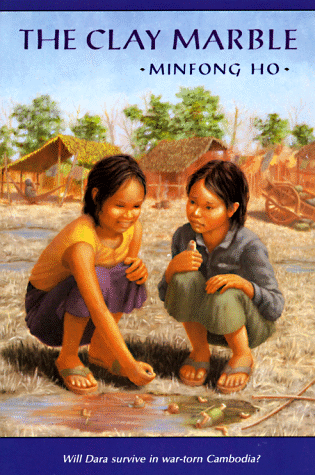The Clay Marble

Editorial Reviews
From Publishers Weekly
Dara's is one of the thousands of Cambodian families separated or destroyed by war, but there is hope as she and her brother and mother head for a refugee camp on the Thailand border. Once safely there, Dara makes friends with Jantu, who has an almost magical touch in creating toys from mud and scraps of fabric. When the camp is bombed, Jantu makes a magic marble out of clay that helps Dara track down her family and then return to the hospital for Jantu and her brother. Like clay dolls themselves, Ho's ( Rice Without Rain ) characters seem to walk through their parts--their emotional turmoil, rather than being revealed, is simply stated. Despite a potentially compelling story and setting, this novel never comes to life. Ages 10-up.
Copyright 1991 Reed Business Information, Inc.
From School Library Journal
Grade 5-9-- After the fall of the Khmer Rouge, 12-year-old Dara, her older brother Sarun, and their mother journey to the Thai border in search of food. Here they meet the remnants of another Cambodian family, one of whose members, Jantu, becomes Dara's friend; another, Nea, falls in love with Sarun. Life is going along well until infighting among neighboring guerrilla groups forces the families to flee again. In the confusion, Dara and Jantu become separated from the main group. After many incidents, they are reunited with their families, although Jantu is shot in the process and dies soon after. Sarun, once a proud farmer, wants to join the military. Dara courageously stands up to him, and convinces him to return home with the family. The title comes from Jantu's effervescence and manual dexterity, the combination of which impresses Dara as magic. She believes a clay marble, having been invested with Jantu's magic, gives her the courage to get through her ordeals. Dara and Jantu are well drawn, but the rest of the characters are not much more than pasteboard figures. Ho excels at tropical description, evoking climate and flaura with skill. The contrasts of frantic activity and enervating inaction of refugee life are also vividly depicted. However, Dara's vocabulary when she thinks to herself does not ring true for her age; few 12-year-olds would consciously characterize themselves as "irritable" or others as "glib"--certainly not illiterate 12-year-olds from rural areas. Older children might find this novel of interest for its historical milieu or slice-of-life realism, albeit from a different reality. --John Philbrook, San Francisco Public Library
Copyright 1991 Reed Business Information, Inc.
From Kirkus Reviews
Drawing on her experience with a relief organization on the Thai border, Ho tells the story of a Cambodian family, fleeing the rival factions of the 80's while hoping to gather resources to return to farming in their homeland. Narrator Dara, 12, and the remnants of her family have arrived at a refugee camp soon after her father's summary execution. At first, the camp is a haven: food is plentiful, seed rice is available, and they form a bond with another family- -brother Sarun falls in love with Nea, and Dara makes friends with Nea's cousin, Jantu, who contrives marvelous toys from mud and bits of scrap; made wise by adversity, Jantu understands that the process of creation outweighs the value of things, and that dead loved ones may live on in memory. The respite is brief: Vietnamese bombing disrupts the camp, and the family is temporarily but terrifyingly separated. Later, Jantu is wounded by friendly fire and doesn't survive; but her tragic death empowers Dara to confront Sarun, who's caught up in mindless militarism instigated by a charismatic leader, and persuade him to travel home with the others--to plant rice and build a family instead of waging war. Again, Ho (Rice Without Rain, 1990) skillfully shapes her story to dramatize political and humanitarian issues. The easily swayed Sarun lacks dimension, but the girls are more subtly drawn--Dara's growing courage and assertiveness are especially convincing and admirable. Touching, authentic, carefully wrought- -and with an unusually appealing jacket. (Fiction. 11-15) -- Copyright ©1991, Kirkus Associates, LP. All rights reserved.
"Touching, authentic, carefully wrought." --Pointer, Kirkus Reviews
Review
"Touching, authentic, carefully wrought." --Pointer, Kirkus Reviews
Description of new work